You manage data every day, but you need someone to make sure that data stays accurate and reliable. A data quality analyst checks, cleans, and monitors your data so you can trust it for business intelligence and decision-making. Many organizations face challenges with data quality. For example:
- 64% of organizations report data quality as the top challenge impacting data integrity.
- 60% list data quality as the top data integrity priority for 2024.
Demand for this role keeps rising as data incidents grow and teams spend more time fixing data problems. Modern solutions like FineDataLink help you tackle these challenges by making data integration smoother and more efficient.
Data Quality Analyst Role and Key Responsibilities

As a data quality analyst, you play a vital role in ensuring that your organization’s data remains accurate, consistent, and ready for business use. Your daily responsibilities focus on maintaining high standards for data quality, which directly impacts business intelligence and decision-making. Let’s break down the core data quality tasks you handle every day.
Data Profiling and Assessment
You start by examining the structure and content of your data. This process, called data profiling, helps you spot missing information, unusual patterns, or inconsistencies. You use data profiling tools to generate summaries and identify trends. These tools help you answer questions like: Are there too many blank fields? Do certain columns have unexpected values? You also check for key integrity and relationships between datasets.
Data profiling is not just about finding errors. It helps you set data standards, enforce best practices, and ensure compliance with regulations. When you profile data, you create a foundation for data quality assurance across your organization.
Here’s a table that summarizes your main responsibilities as a data quality analyst:
| Responsibility | Description |
|---|---|
| Data Profiling | Analyze data structure, patterns, and content to find issues like missing info. |
| Data Cleaning | Correct or remove inaccurate or irrelevant data for a high-quality dataset. |
| Data Validation | Make sure data meets standards and business rules for accuracy and completeness. |
| Data Integration | Merge data from different sources and resolve discrepancies. |
| Data Monitoring | Track data to ensure accuracy and reliability over time. |
You also use basic techniques like counting unique values, checking for blanks, and measuring string lengths. Advanced techniques include checking key integrity and analyzing data patterns. These steps help you understand your data before you move on to cleaning and validation.
Data Cleaning and Validation
Once you know where the problems are, you focus on data cleaning and preprocessing. You correct errors, remove duplicates, and standardize formats. This step is essential because dirty data can lead to costly mistakes. For example, companies can lose up to 25% of their revenue due to poor data management. Clean data helps you make better decisions, reduce costs, and improve productivity.
You use data validation tools to check that your data meets business rules. You verify data types, run field checks, and use double-key verification to catch discrepancies. You also back up original data and keep detailed records of every change. These practices ensure transparency and make it easier to reproduce your results.
Tip: Automation tools can help you reduce manual errors and speed up data cleaning and preprocessing. They also make it easier to monitor trends and spot recurring issues.
Data Monitoring and Reporting
Your job does not end after cleaning and validation. You need to keep an eye on data quality over time. Data quality monitoring involves tracking key metrics like accuracy, timeliness, and uniqueness. You use dashboards to visualize these metrics and share them with other teams.
You generate two main types of reports:
- Data quality dimension-focused dashboards. These show how complete and accurate your data is.
- Data consumer-focused dashboards. These help users like data scientists trust the data for their analysis.

You should conduct data audits at least once a year. In fast-changing industries, you may need to monitor data quality more often. Continuous data quality monitoring helps you catch problems early and keep your data reliable.
Collaboration and Documentation
You do not work alone. Data quality analysts often collaborate with engineers, business analysts, and other teams. This teamwork helps you align data quality tasks with business goals and streamline data systems. Cross-functional collaboration leads to faster turnaround times and better customer service.
Documentation is another key responsibility. You create clear data quality standards and validation checklists. Good documentation helps everyone follow the same rules and makes troubleshooting easier. It also supports a strong data quality culture across your organization.
Note: FanRuan’s solutions promote structured governance and a data quality culture. By investing in data quality tools and clear documentation, you help your organization avoid common pitfalls like human error and outdated information.
As a data quality analyst, your responsibilities go beyond fixing errors. You build trust in your organization’s data, support better decision-making, and drive operational efficiency. Your work ensures that everyone can rely on the data for business intelligence and growth.
Essential Skills for Data Quality Analysts
Technical and Analytical Skills
You need a strong set of technical and analytical abilities to succeed as a data quality analyst. These skills help you handle data management tasks and solve problems quickly. Here are the essential skills for an ai data quality analyst:
- Data cleansing lets you remove errors and keep your datasets reliable.
- Data visualization helps you present findings with charts and graphs.
- Statistics allow you to spot patterns and make predictions.
- Database management gives you the power to organize and interpret large datasets.
- Programming languages such as SQL, Python, and R help you manipulate data and extract insights.
- Domain knowledge provides context for your analysis and ensures your work fits the needs of your industry.
You often use programming languages to complete your daily tasks. The table below shows which languages employers request most often:
| Programming Language | Percentage of Job Postings |
|---|---|
| SQL | 61% |
| Python | 56% |
| Scala | 13% |
You use these tools to automate data management, clean data, and build reports. Mastering these technical skills prepares you for advanced roles and helps you deliver accurate results.
Communication and Problem-Solving
You must also develop strong communication and problem-solving skills. These are essential skills for an ai data quality analyst because you work with many teams and need to explain your findings clearly. The table below highlights the most important abilities:
| Skill Type | Description |
|---|---|
| Communication and Collaboration | Work with stakeholders to share information |
| Understanding Business Requirements | Learn what your organization needs from its data |
| Analytical and Problem-Solving Skills | Find solutions to data issues |
| Data Pattern Recognition | Spot trends and unusual data points |
| Data Quality Assessment | Identify areas that need improvement |
You resolve conflicts by communicating business requirements, using data testing tools, and validating assumptions with assertions. These steps help you prevent misunderstandings and keep your data management process smooth. Building these essential skills for an ai data quality analyst ensures you can handle challenges and support your organization’s goals.
Tools and Technologies: FineDataLink and More

Data Integration Platforms (FanRuan, FineDataLink)
You need reliable platforms to manage and connect your data. FineDataLink stands out as a top choice for data integration and quality. It helps you collect, synchronize, and share data from many sources. You can use it with relational databases, files, and APIs. FineDataLink offers a low-code platform, so you can build solutions quickly and easily. The drag-and-drop interface makes your work faster and more efficient.
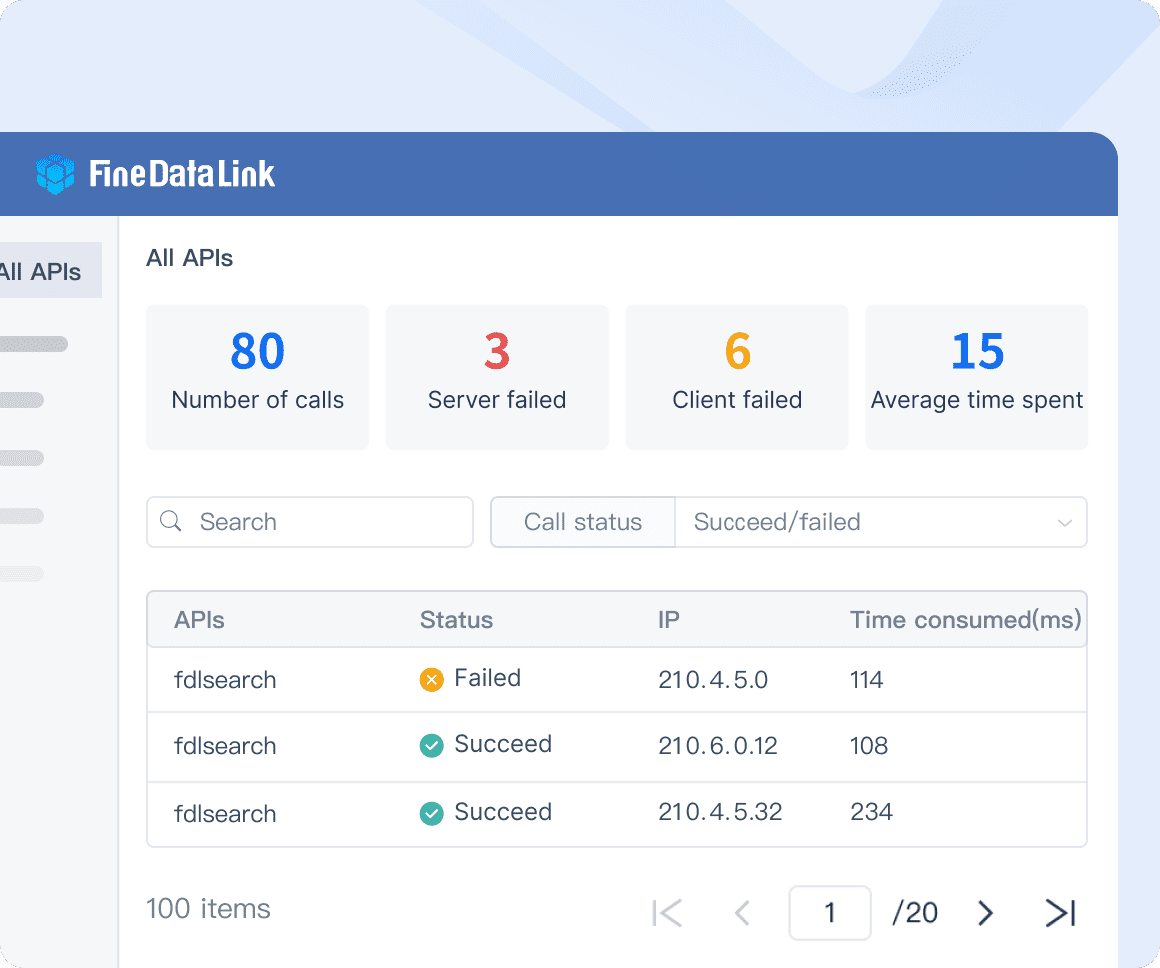
Here is a table that shows what makes FineDataLink unique:
| Key Feature | Description |
|---|---|
| Multi-source data collection | Supports many types of data sources, including files and databases. |
| Real-time synchronization | Keeps your business data up to date with fast, non-intrusive syncing. |
| Low-cost data service construction | Lets you build data assets and share them using APIs. |
| Efficient operation and maintenance | Schedules tasks and monitors them in real time, reducing your workload. |
| High extensibility | Uses Spark SQL and supports scripts for custom solutions. |
| Dual-core engine | Handles both ETL and ELT processes for flexible development. |
| Multiple sync methods | Offers several ways to synchronize data, like by timestamp or log parsing. |
| Security measures | Protects your data with encryption and SQL injection prevention. |
| User-friendly low-code platform | Easy to use, even if you are new to data integration. |
You also benefit from extensive documentation and cost-effective solutions. FineDataLink helps you manage large data volumes and supports real-time data pipelines.
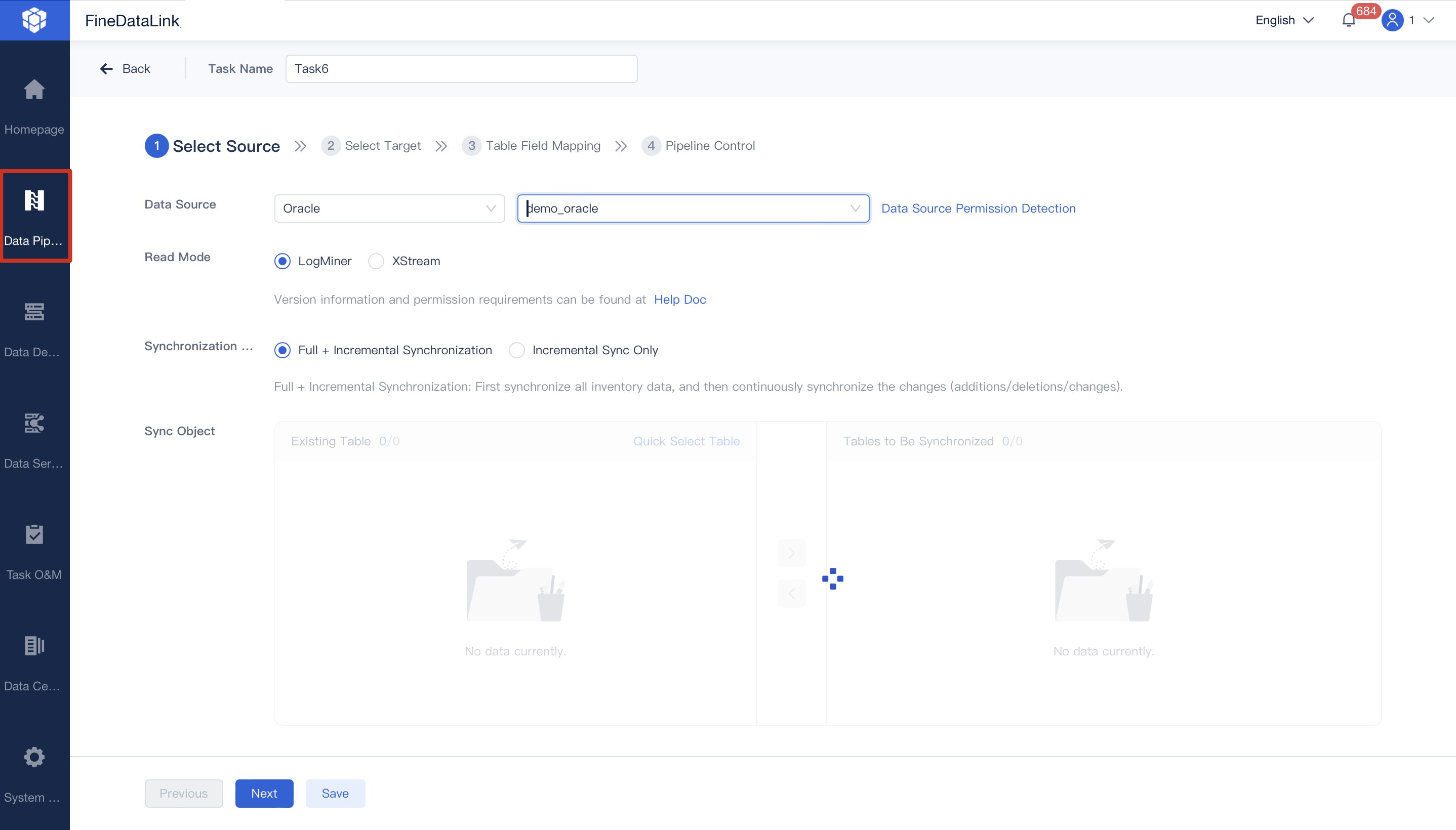
ETL, ELT, and Data Profiling Tools
You often use ETL (Extract, Transform, Load) and ELT (Extract, Load, Transform) tools to move and clean your data. Popular options include Matillion, IBM DataStage, Informatica PowerCenter, Dataform, Airbyte, Rivery, and ETLeap. These tools help you automate data flows and keep your data organized.
Data profiling tools play a key role in your workflow. They help you find patterns, spot errors, and check for missing or unusual values. Data profiling gives you a clear view of your data’s structure and content. It also helps you follow industry rules and prevent data breaches. For example, if a column should have dates but contains “N/A,” data profiling will flag this so you can fix it. Automated data profiling tools save you time and reduce manual work.
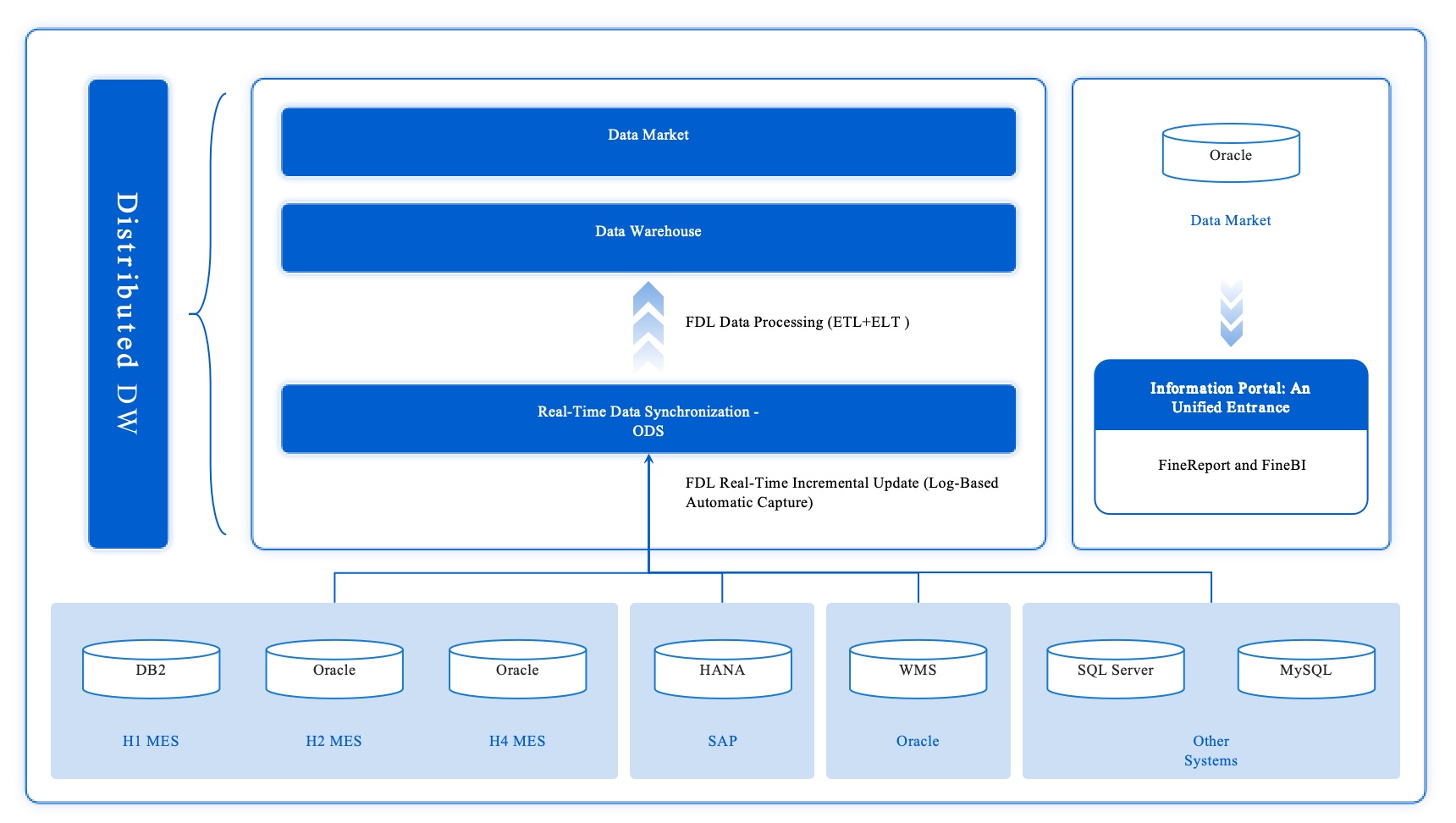
Data profiling tools help you identify anomalies and inconsistencies, making your data more reliable for decision-making.
Automation and Real-Time Data Solutions
Automation changes how you manage data quality. Automated systems provide continuous monitoring and real-time alerts. You get notified about issues as soon as they happen. This means you can fix problems before they spread. Automation also helps you track data quality metrics and take immediate action when needed.
Here is a table that shows how automation improves real-time data quality:
| Feature | Description |
|---|---|
| Continuous Monitoring | Watches your data all the time and finds problems right away. |
| Immediate Detection | Spots issues instantly, so bad data does not move through your systems. |
| Proactive Management | Helps you prevent problems before they become serious. |
You can also use data observability tools to keep an eye on your data pipelines. These tools help you understand how data moves and where issues might appear. With the right technology, you can ensure your data stays accurate, secure, and ready for business use.
Challenges in Data Quality and Solutions
Common Data Quality Issues
You face many data quality issues in your daily work. These problems can affect your business decisions and slow down your progress. Here are the most frequent data quality issues organizations encounter:
- Duplicate data
- Inaccurate data
- Ambiguous data
- Hidden data
- Inconsistent data
- Too much data
- Data downtime
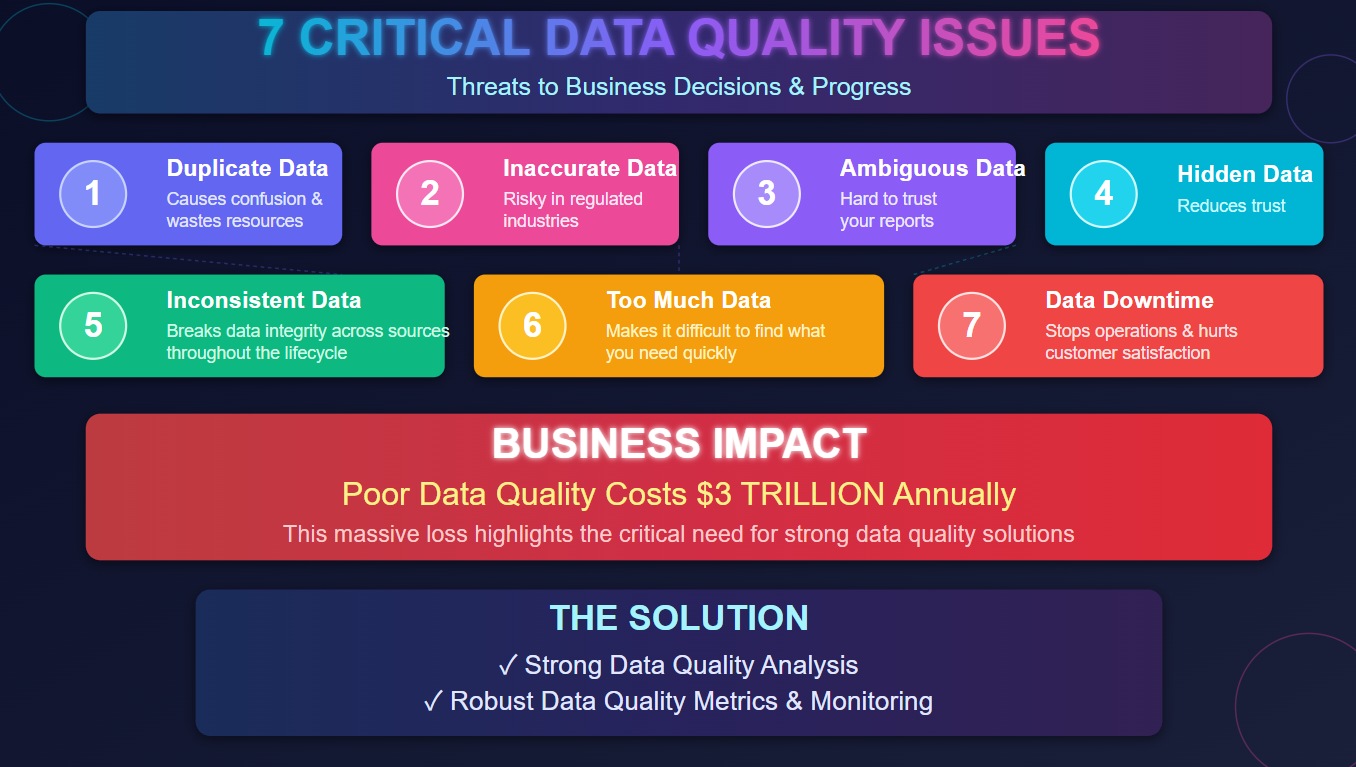
Duplicate data can lead to confusion and wasted resources. Inaccurate data is especially risky in industries with strict rules. Ambiguous or hidden data makes it hard to trust your reports. Inconsistent data across sources can break data integrity throughout the lifecycle. Too much data can make it difficult to find what you need. Data downtime can stop your operations and hurt customer satisfaction.
Poor data quality costs businesses about $3 trillion every year. This huge loss shows why you need strong data quality analysis and data quality metrics to keep your data reliable.
Overcoming Data Silos and Integration Barriers
You often see data trapped in separate systems or departments. These silos make it hard to get a full picture of your business. To overcome these barriers, you can:
- Merge data from different sources into one system for better analysis.
- Set clear data governance policies to keep data quality high.
- Encourage teamwork across departments to share insights.
- Use advanced analytics to find patterns in your integrated data.
- Create unified reporting tools for real-time data monitoring.
You should also foster a culture where everyone sees data as a shared asset. Adopting advanced integration tools helps you centralize your data and automate data cleansing and enrichment. This approach makes it easier to track data quality metrics and improve your data quality analysis.
Ensuring Data Consistency with FanRuan Solutions
FanRuan offers powerful solutions to help you maintain data consistency across multiple sources. You can use features like data comparison, data integration, and scheduled tasks to automate data cleansing and enrichment. The table below shows how FanRuan supports your data governance efforts:
| Feature | Description |
|---|---|
| Data Comparison | Check data consistency by comparing source and target data. |
| Data Integration | Integrate different types of data for better association and modeling. |
| Scheduled Task Capabilities | Automate tasks to keep data consistent over time. |
With these tools, you can monitor data quality metrics, ensure data integrity throughout the lifecycle, and support strong data governance. FanRuan helps you build trust in your data and make better business decisions.
Data Quality Analyst vs. Related Roles
Data Analyst vs. Data Quality Analyst
You may wonder how a data analyst and a data quality analyst differ. Both roles work with data, but their main goals are not the same. A data analyst looks for insights and trends in data. You use tools to create reports, spot patterns, and help your team make decisions. Your work supports product development and gives your company a competitive edge.
A data quality analyst, on the other hand, focuses on making sure the data is accurate and reliable. You check for errors, clean up problems, and set standards for data quality. You also monitor data over time and improve processes to keep data trustworthy. Your work helps your company avoid mistakes and build trust with stakeholders.
Here is a table that shows the main differences:
| Aspect | Data analyst | Data quality analyst |
|---|---|---|
| Focus | Analyzing data for insights and trends | Ensuring data accuracy and integrity |
| Responsibilities and tasks | Data analysis, trend identification, visualization, reporting, decision support, exploratory data analysis, collaborating for insights | Data profiling and assessment, data cleansing, data quality standards development, monitoring data quality, root cause analysis, process enhancement |
| Skill sets required | Data analysis tools, statistical knowledge, data visualization tools, communication skills, problem-solving abilities, domain knowledge | Data profiling techniques, data quality standards, data cleansing techniques, SQL proficiency, attention to detail, problem-solving skills |
| Impact on organizations | Strategic decision-making, market insights, competitive advantage, product development support | Enhanced data integrity, minimized operational inefficiencies, compliance support, stakeholder trust |
Tip: If you want to help your company make better decisions, you might enjoy being a data analyst. If you like solving problems and making sure data is correct, the data quality analyst role could be a better fit.
Data Engineer and AI Data Quality Analyst
You may also hear about data engineers and AI data quality analysts. A data engineer builds and maintains the systems that store and move data. You design data pipelines, set up databases, and make sure data flows smoothly between systems. Your work gives analysts and business teams the data they need.
An AI data quality analyst uses artificial intelligence to check and improve data quality. You use machine learning tools to find errors, spot patterns, and automate data checks. This role is growing as companies handle more data and need faster ways to keep it clean.
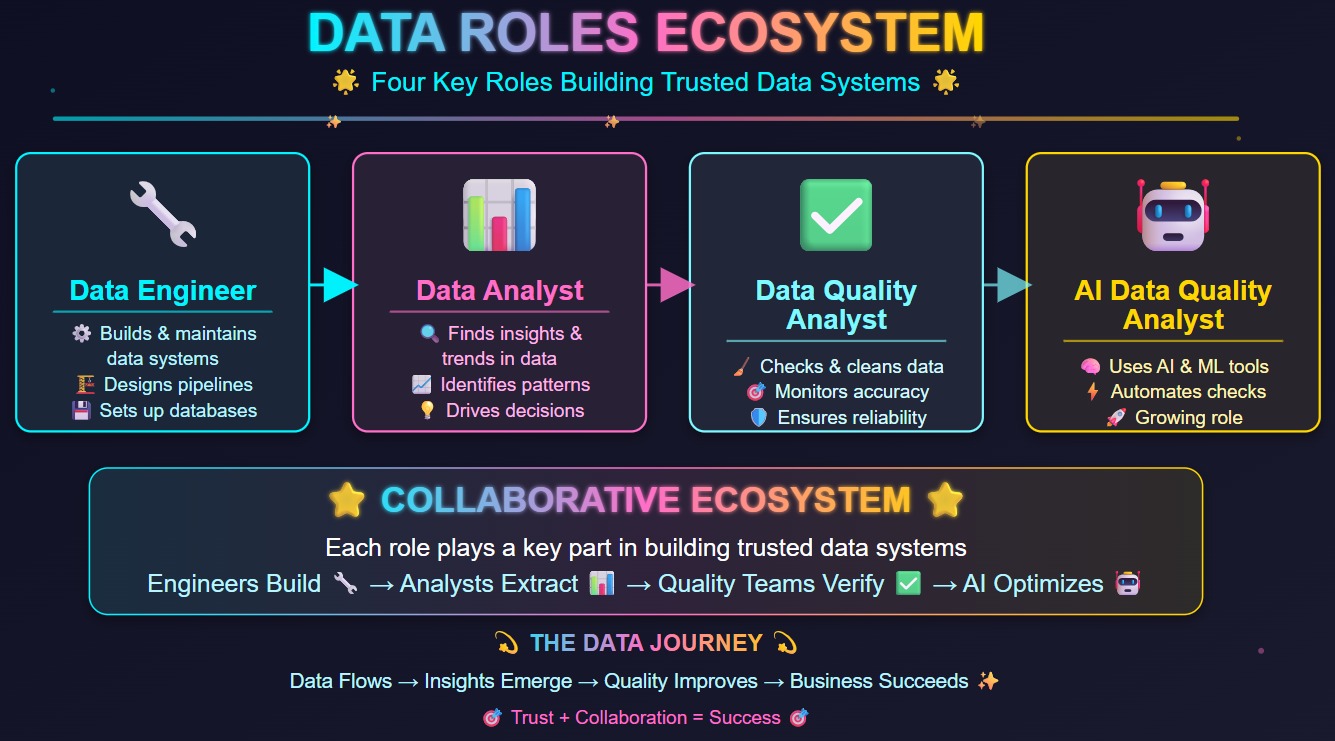
Here is a quick list to help you see the differences:
- Data engineer: Builds and manages data systems and pipelines.
- Data analyst: Finds insights and trends in data.
- Data quality analyst: Checks, cleans, and monitors data for accuracy.
- AI data quality analyst: Uses AI to automate and improve data quality tasks.
Each role plays a key part in making sure your company can trust and use its data.
Career Path and Future Trends
Growth Opportunities
You can build a strong career as a data quality analyst. Many organizations need experts who can keep their data accurate and reliable. You see more companies using data to make decisions. This creates new jobs and opens doors for you. You can start as a junior analyst and move up to senior roles. You may lead teams or manage data quality projects. Some people become consultants and help different companies solve data problems. You can also work in many industries, such as healthcare, finance, retail, and manufacturing.
- The role of data quality analysts is becoming increasingly important as organizations depend more on data for decision-making.
- There is a rising demand for skilled professionals in the field of data quality analysis.
You can learn new skills and earn certifications. You may study data management, analytics, or business intelligence. You can also join professional groups and attend workshops. These steps help you grow and stay updated with the latest trends.
The Rise of AI Data Quality Analyst Roles
You see a big change in the field with the rise of ai data quality analyst roles. Many companies use artificial intelligence to handle data. This creates new jobs for ai data quality analyst experts. You need to make sure that AI models use clean and accurate data. You check for errors and fix problems before they affect results. You also help detect bias and keep data transparent.
- The rise of AI has led to the emergence of specialized roles like ai data quality analyst, which are crucial for ensuring data integrity in AI models.
- As AI automates traditional data preparation tasks, the demand for professionals who can maintain high-quality data is increasing.
- The complexity of the data landscape and the introduction of generative AI necessitate a focus on data governance, bias detection, and transparency, further elevating the need for ai data quality analyst.
You work with teams to set rules and monitor data. You use new tools and learn about machine learning. You help companies trust their AI systems. You may also teach others how to keep data safe and fair. The future looks bright for ai data quality analyst roles. You can shape how companies use AI and data.
You play a key role as a data quality analyst. You help your company trust its data and make better decisions. Advanced tools like FineDataLink make data quality management easier and more effective. If you want a future-proof career, explore opportunities in this growing field. Start improving your skills or help your organization by learning more about FanRuan solutions.
FAQ

The Author
Lewis
Senior Data Analyst at FanRuan
Related Articles

How Can Employee Retention Software Help Lower Turnover Rate
Employee retention software lowers turnover by tracking engagement, identifying risks, and supporting recognition to keep employees satisfied and loyal.
Lewis
Nov 16, 2025

What is Retention and Why It Matters Across Different Fields
What is retention? It means keeping customers, employees, or knowledge over time—a key metric for loyalty, value, and success in any field.
Lewis
Nov 16, 2025

What is Data as a Product and What Make It Valuable
Data as a product means treating data as a user-focused asset, driving business value through quality, usability, and actionable insights.
Lewis
Nov 16, 2025




